Tomato plants are vigorous climbers whose sprawling vines benefit tremendously from vertical support. By training tomatoes upward, you not only boost air circulation and sun exposure—leading to healthier plants and higher yields—but also keep fruit off damp soil, reducing disease and pest pressures. Vertical systems free up ground space for interplanting or pathways, create attractive garden features, and simplify pruning and harvesting. From simple stakes to elaborate cable networks, there’s a trellis for every skill level, budget, and garden aesthetic. Below are 20 ideas—ranging from classic to creative—each outlined with key features, materials, and benefits to help you choose the perfect support system for your tomatoes.
1. Traditional Tomato Cages
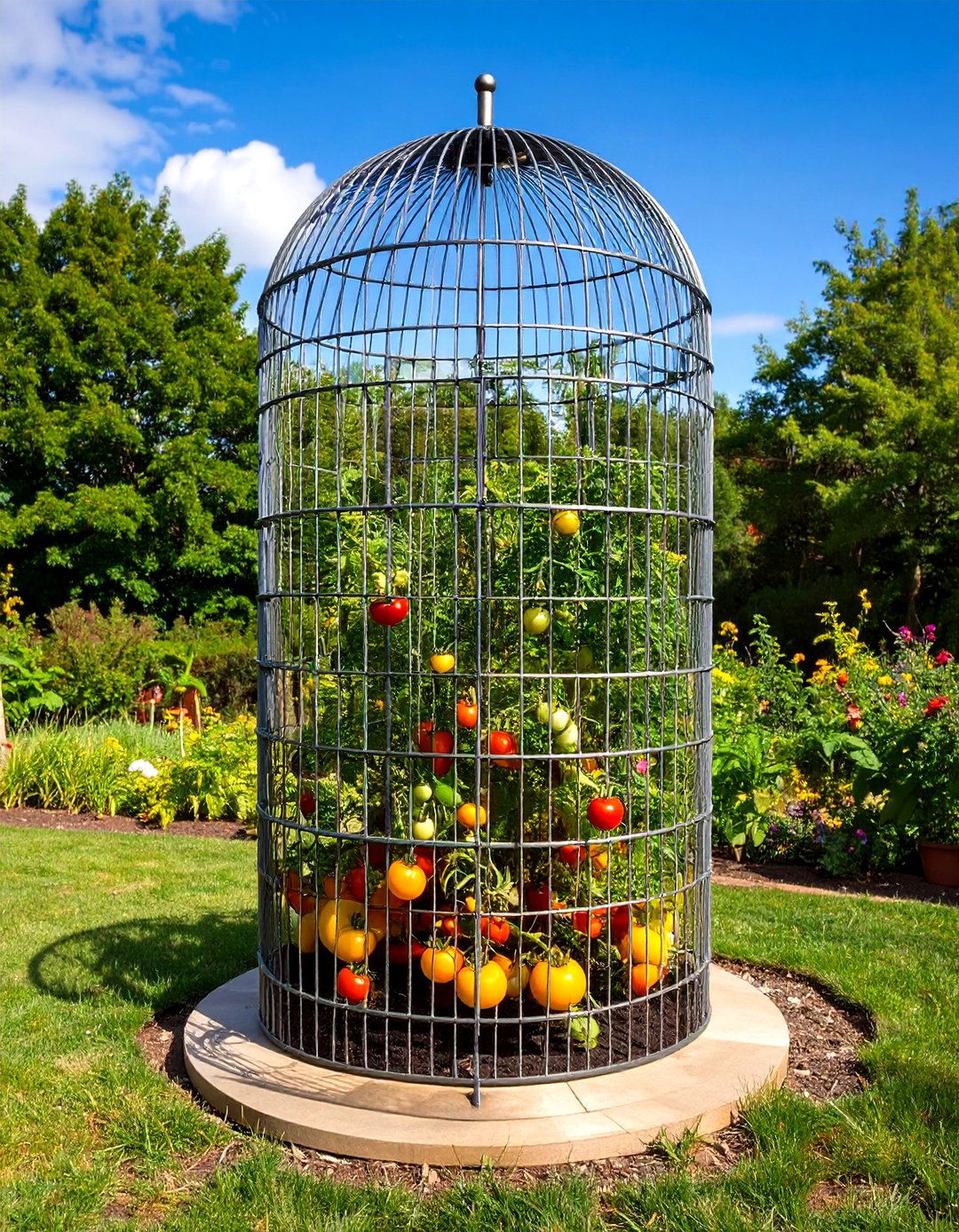
Tomato cages are cylindrical supports, often made of steel wire or concrete-reinforcing mesh, and are among the most familiar home-garden solutions for determinate and compact varieties. They slip over young plants and cradle vines as they grow, preventing sprawling and fruit rot. While easy to install and reusable, standard cages may be too short for tall indeterminate types, causing vines to flop over the top. Upgrading to taller or sturdier DIY wire cages can accommodate vigorous vines and heavy fruit loads, keeping your tomatoes upright and accessible throughout the season.
2. Florida Weave (Posts and Twine)
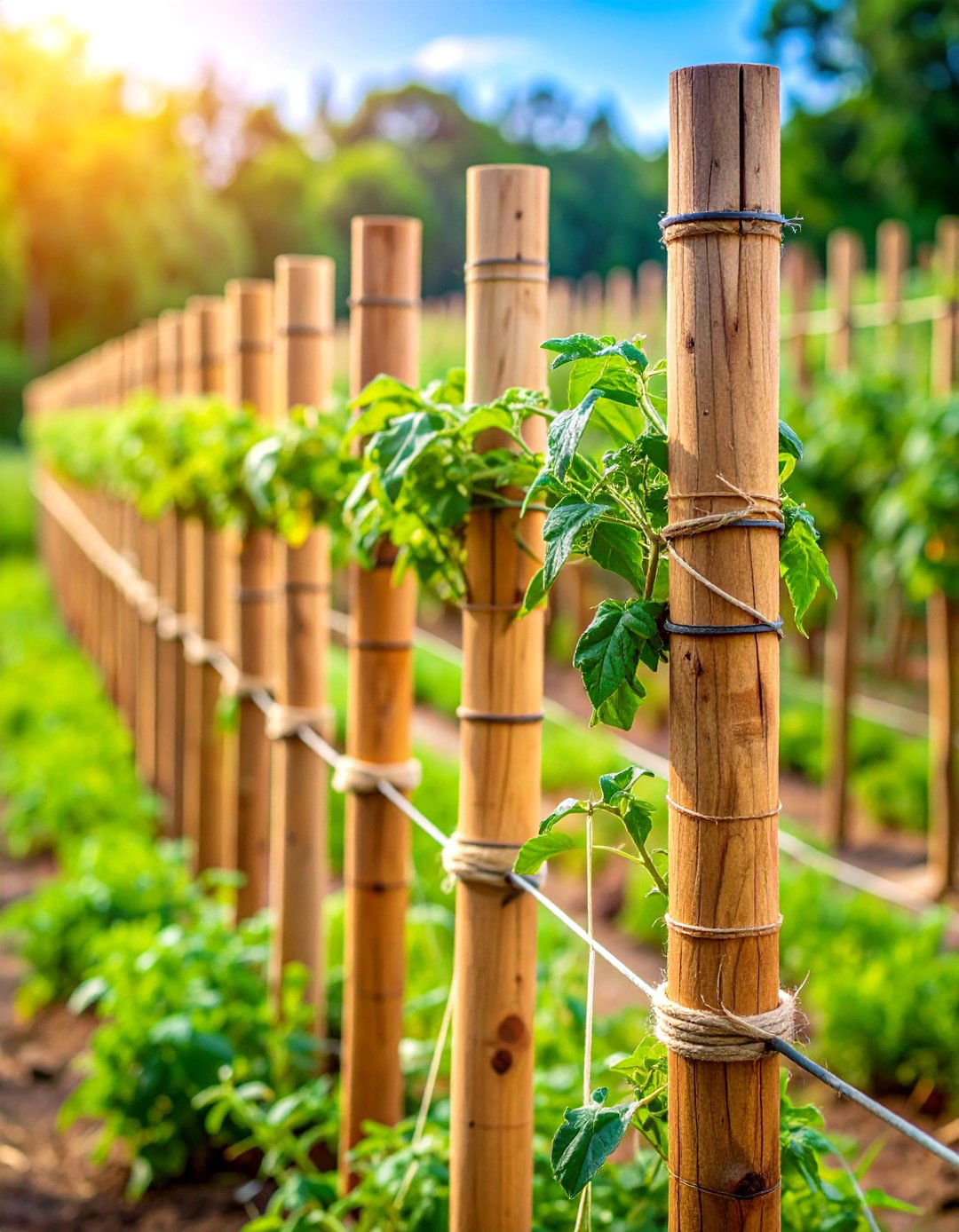
The Florida weave uses a series of posts spaced along a row of tomato plants, with twine woven back and forth to create horizontal support levels. Install wooden or metal posts at each end of the bed and between every two to three plants, then wrap UV-resistant twine around each post at intervals as vines grow. This method is cost-effective, adapts to any plant spacing, and provides strong lateral support without bulky cages. Because minimal pruning is required, it works well for both determinate and indeterminate varieties, forming a tidy “wall” of fruit that’s easy to harvest.
3. A-Frame Trellis
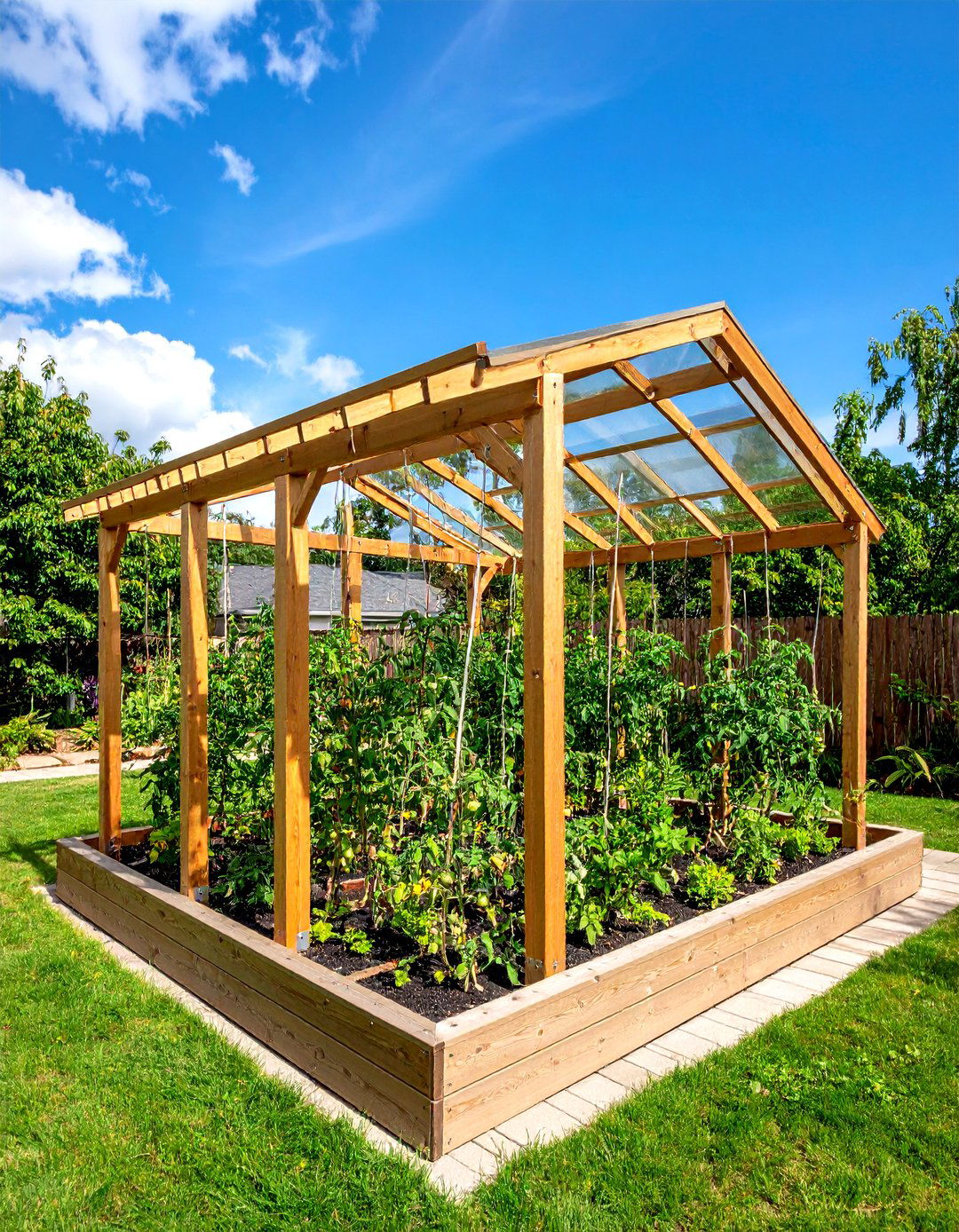
An A-frame trellis consists of two angled panels joined at the top, forming an inverted “V” that supports vines on both sides. Construct frames from wood or metal poles and attach wire mesh or twine between them. As plants grow, you can gently wrap vines around the mesh or tie them to the frame. A-frames stand free and are taller than most cages, making them ideal for indeterminate tomatoes. Their self-supporting design also makes them easy to move, and the open center aisle allows excellent air circulation and access for maintenance.
4. Ladder-Style Trellis
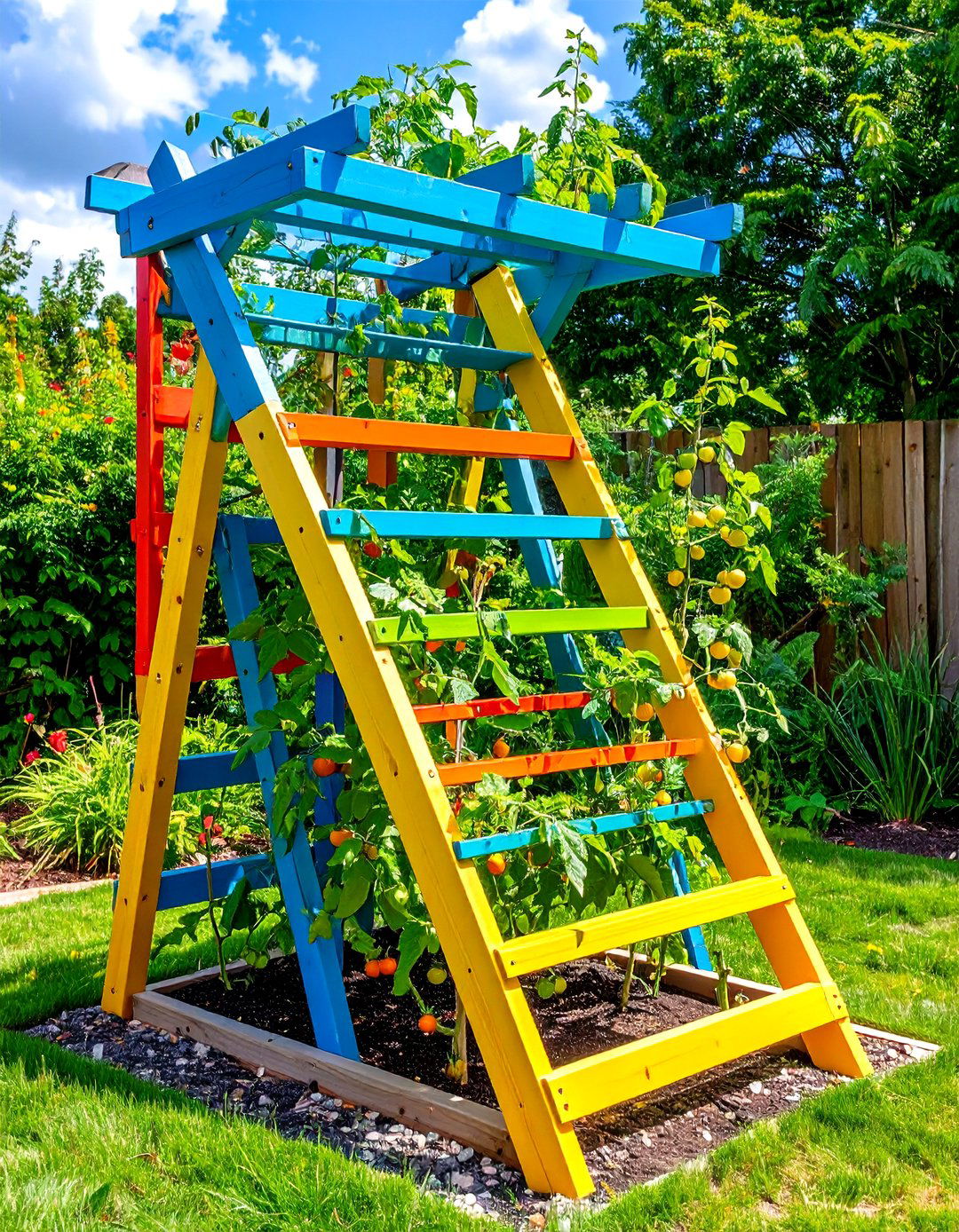
Ladder trellises feature horizontal rungs—often painted bright colors—for vines to climb, combining functionality with garden décor. Made from repurposed wood or purchased ladder sections, this design encourages vines to grow vertically between rungs. The visual appeal is high, and the width accommodates multiple stems. For best results, install the ladder against a fence or brace it firmly in the ground. Use soft ties or clips to secure vines to rungs, and prune to few main stems so each plant climbs neatly.
5. T-Post Trellis
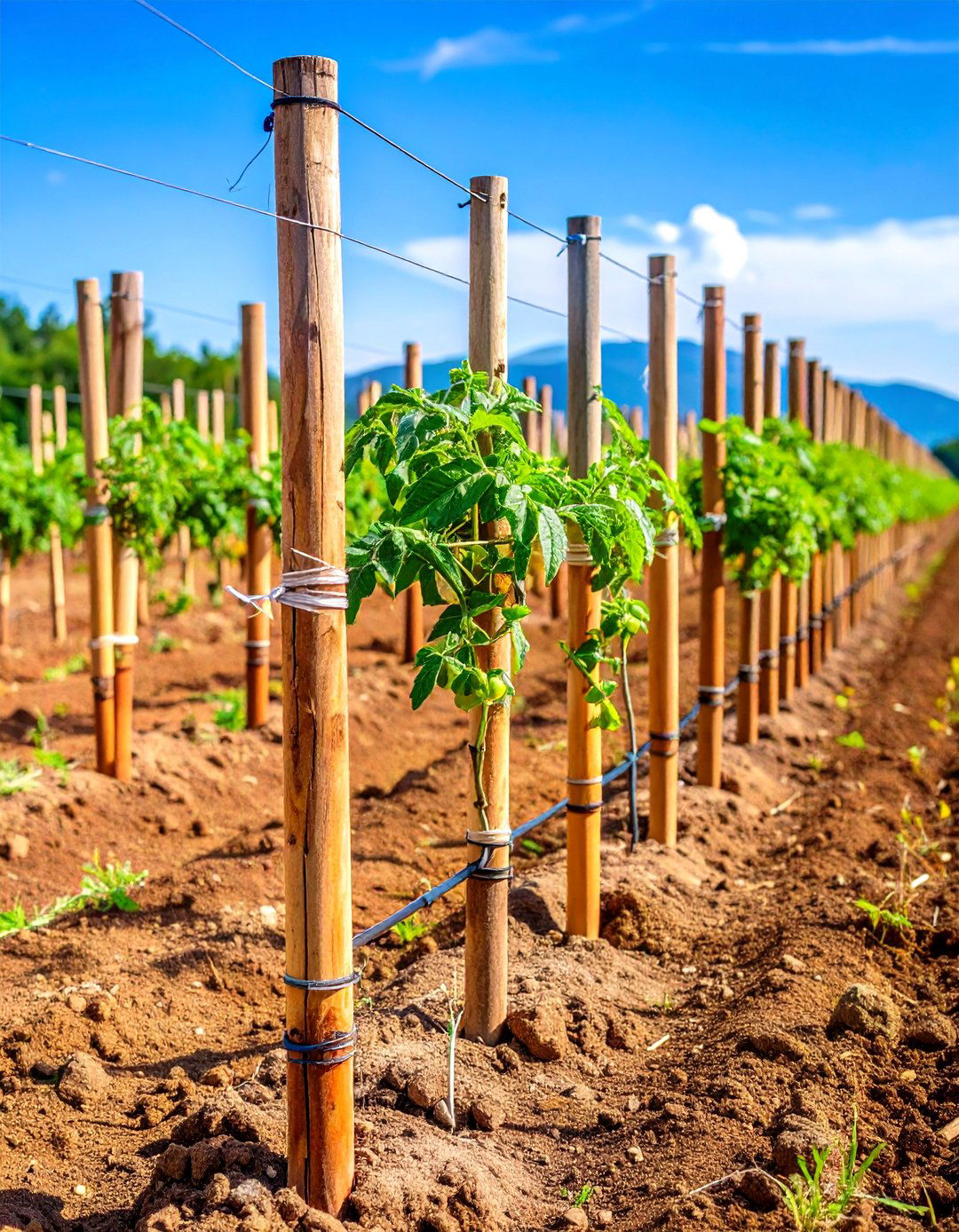
Steel T-posts driven into the ground beside each plant or row provide extremely sturdy vertical support. Each 7' post leaves roughly 6' aboveground—ample height for the tallest indeterminate varieties. Tie vines to the posts with twine or plant clips, moving ties upward as plants grow. T-posts are inexpensive, readily available from farm-supply stores, and require no assembly beyond driving them in. Their durability makes them a lifetime investment, and they can also anchor other trellis materials like cattle panels or wire mesh.
6. Cone (Pyramid) Trellis
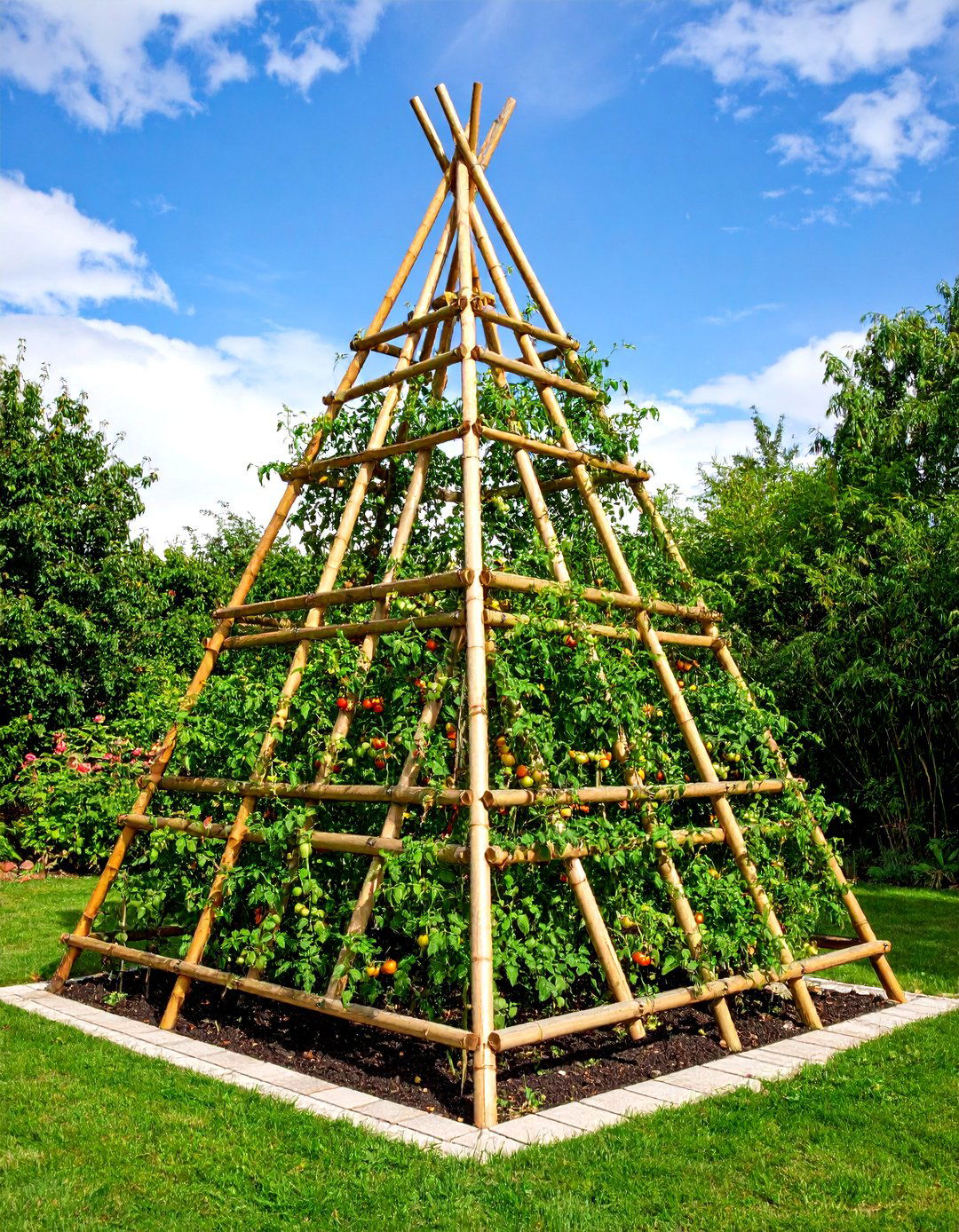
Cone or pyramid trellises are constructed by gathering poles—bamboo or wooden—and fastening them together at the top, forming a teepee shape. Spread the bases out around a planting spot so vines can climb all sides. This design is inexpensive, easy to disassemble for storage, and provides 360° access to fruit. Add cross-supports or horizontal rings of twine for extra strength. Conical structures suit small spaces and create a striking vertical focal point in vegetable beds.
7. Arch (Cattle-Panel) Trellis
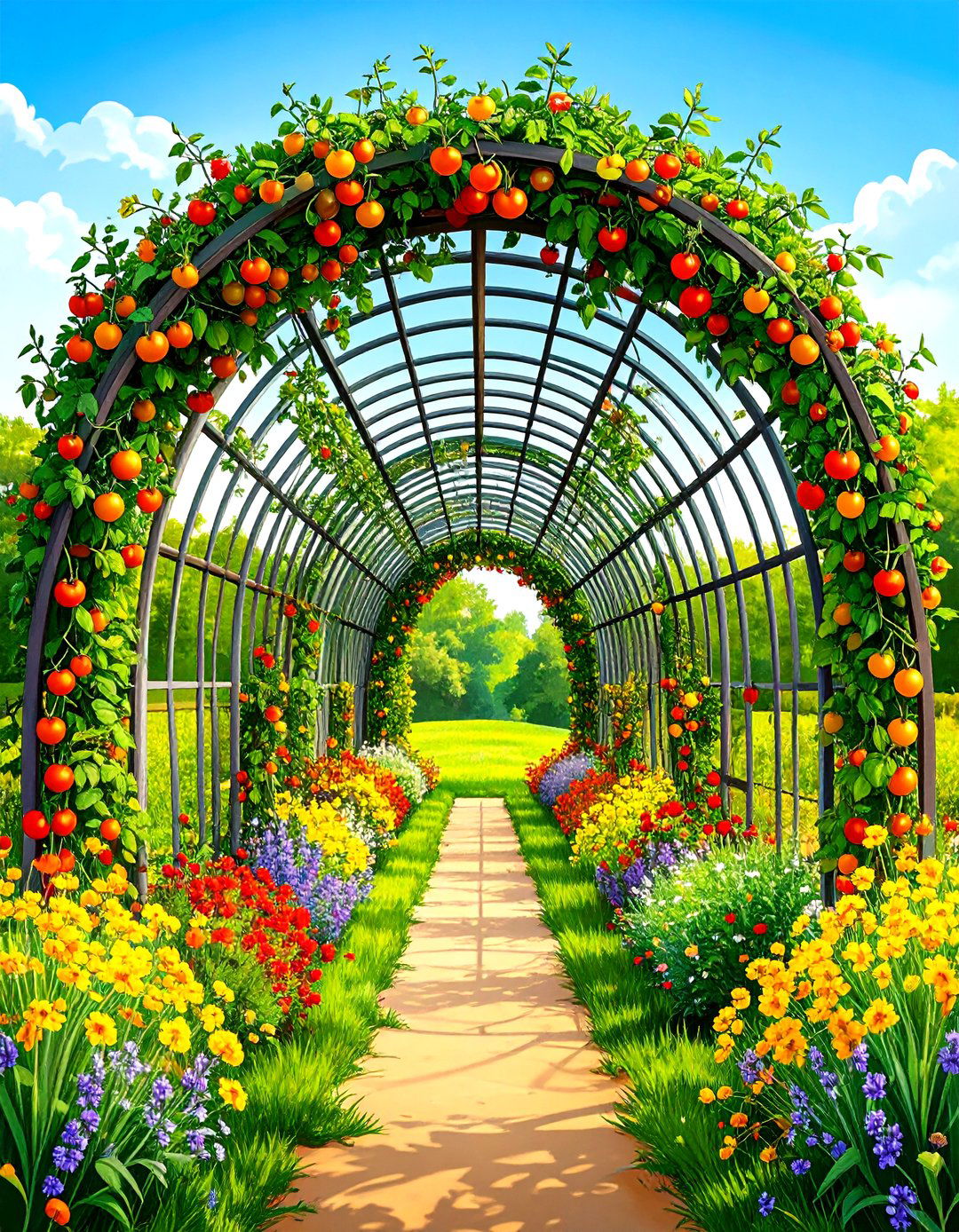
Bending cattle-panel fence into an arch creates a dramatic tunnel effect that supports heavy indeterminate vines. Secure the ends in the ground or to posts on either side of a raised bed, allowing vines to climb both arch sides. This method uses sturdy, readily available fencing panels and requires minimal framing. The tunnel not only maximizes vertical space but also simplifies harvesting—just walk under the arch and pick fruit at eye level. The design also doubles as a decorative garden feature.
8. Stake-and-Weave Hybrid Trellis

Combining the Florida weave with individual stakes creates a hybrid system that offers both vertical and lateral support. Place stakes between each plant, and after vines reach several inches tall, weave twine in a zigzag pattern around stakes and plants at multiple heights. The result is a tidy row of vines supported on both fronts. Minimal pruning keeps more fruit, while directed growth around stakes prevents sprawling. This approach works well in raised beds and incorporates the benefits of both single-leader and weave methods.
9. Obelisk Trellis
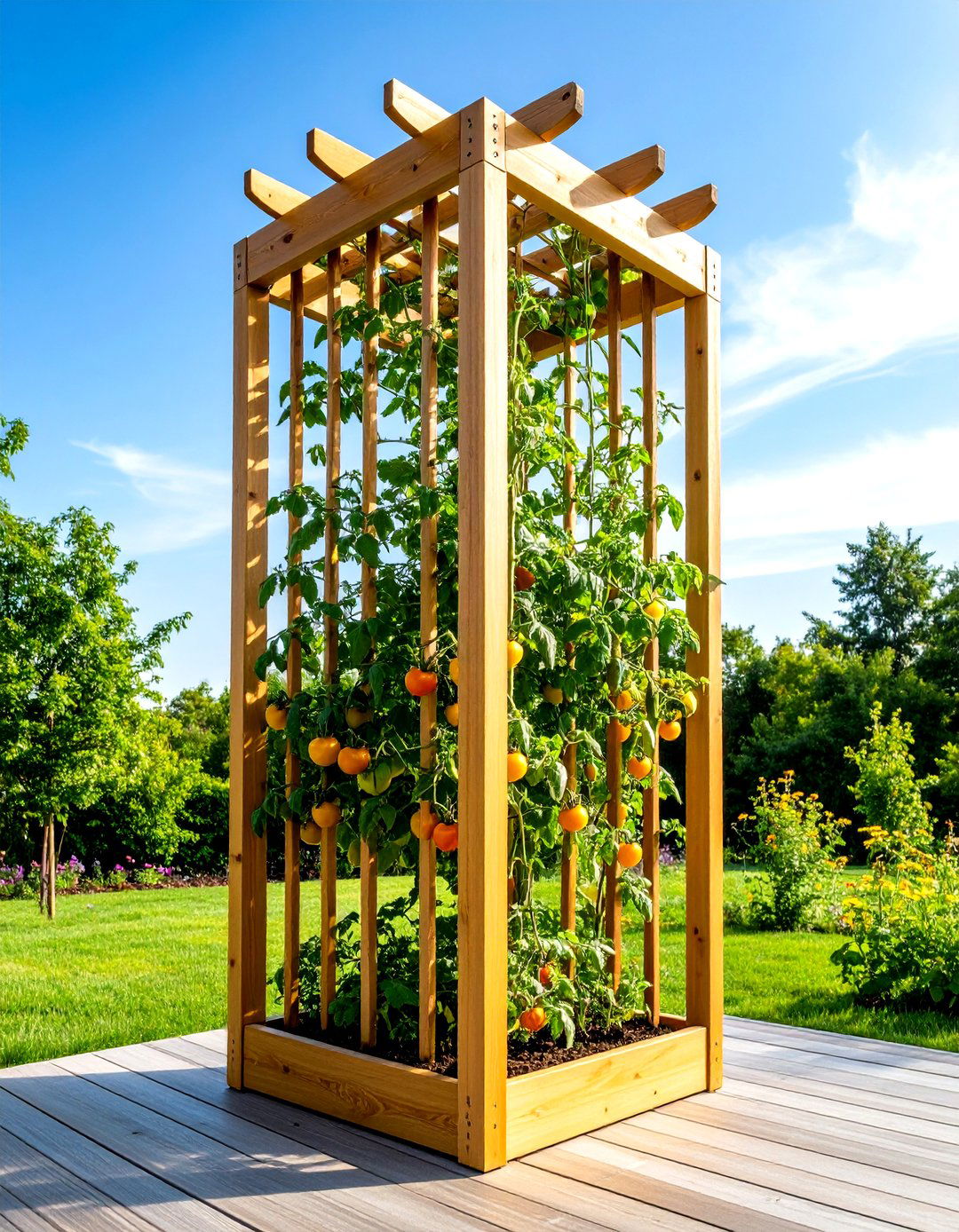
Obelisks—tall, tapering four-sided frames—offer a decorative yet functional support for single tomato plants. Construct from wood, metal rods, or purchased garden structures, and wrap vines around the sides as they grow. Obelisks are space-efficient for container gardening and small plots, elevating fruit display. Use soft ties to fasten vines gently. Their sculptural form adds vertical interest even when vines are dormant.
10. Bamboo-Pole Trellis

Bamboo is a renewable, lightweight, and strong material for tomato supports. Drive pairs of bamboo poles into the soil on either side of a plant or row, then stretch horizontal twine between them at various levels. Vines can climb on twine or be trained directly to poles. Bamboo’s natural resistance to rot and flexibility allows easy installation and removal. This eco-friendly method is ideal for DIY gardeners seeking sustainable materials.
11. PVC-Pipe Trellis
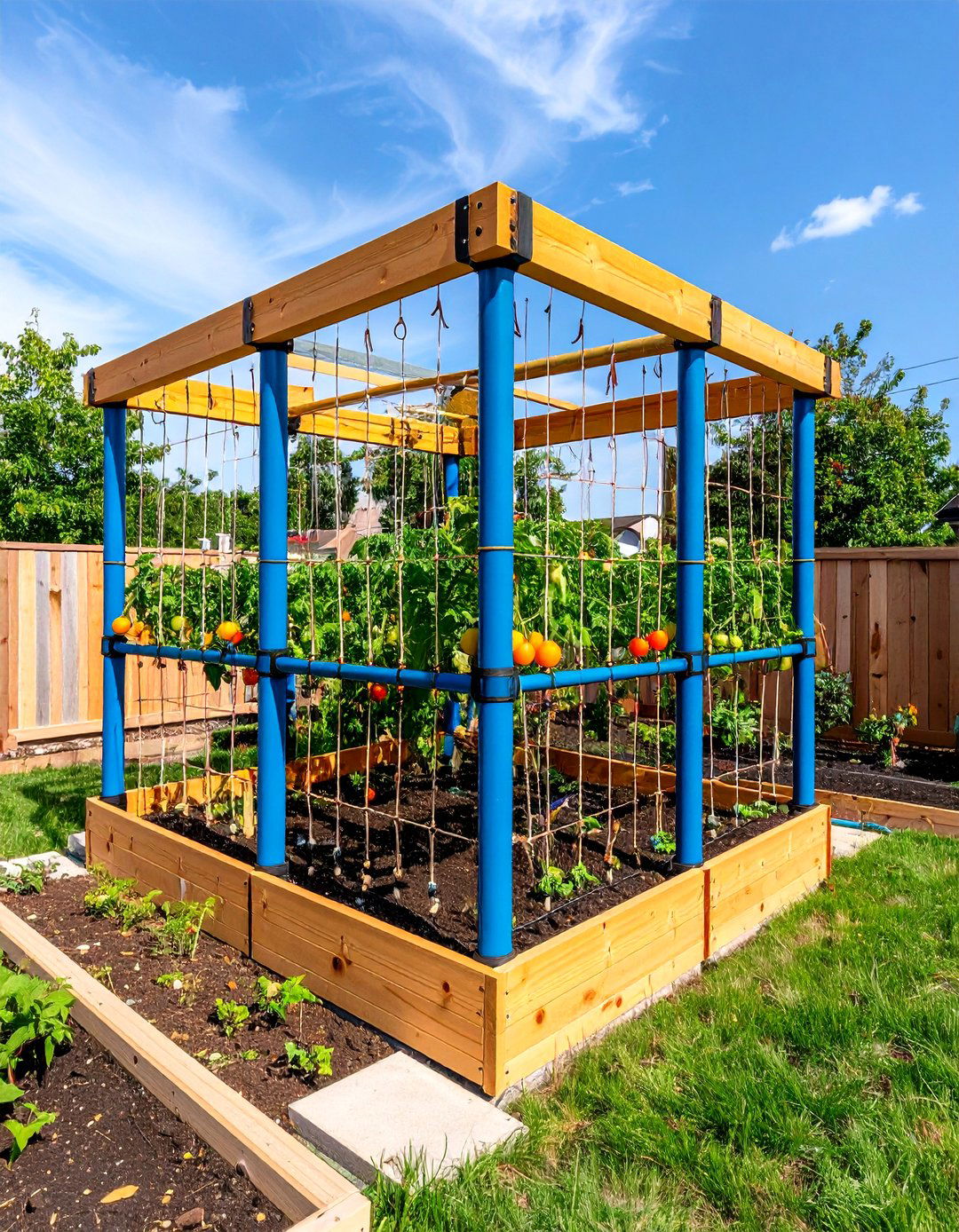
PVC-pipe structures can be built into cages or freestanding frames that resist rust and are easy to sanitize. Assemble pipe sections with T- and elbow-connectors into rectangular or cylindrical cages, or build A-frames. Drive the lower pipes 12–18" into the ground for stability. Use twine or clips to attach vines to the frame. Although lightweight, PVC can flex under heavy loads; consider adding rebar stakes inside the legs for extra support.
12. Netting Trellis
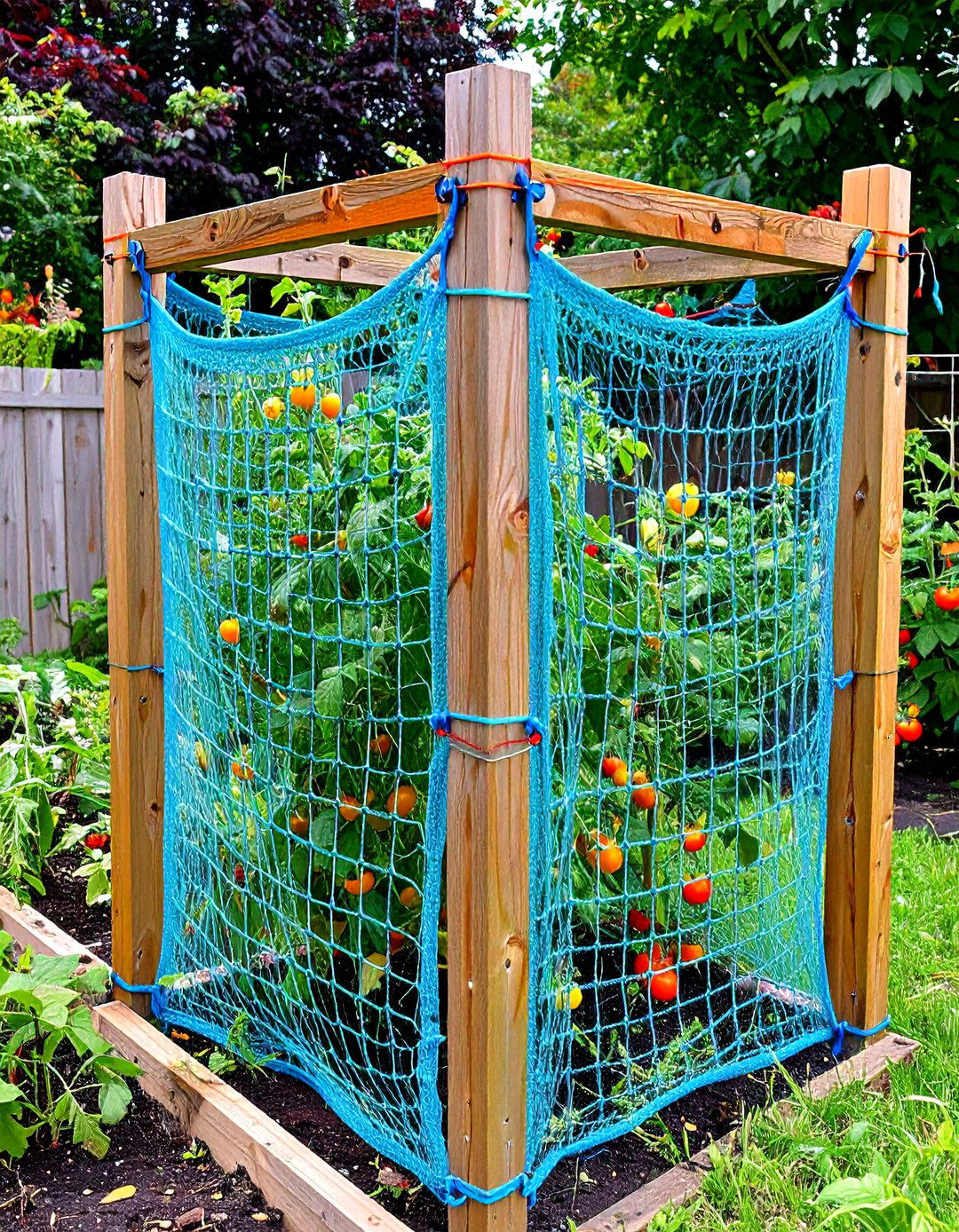
Installing heavy-duty garden netting between posts creates a flexible mesh for vines to grasp. Stretch netting vertically between wooden or metal stakes and tie vines as they ascend. Netting accommodates multiple stems per plant and reduces single-stem stress. It’s particularly effective in narrow rows or against fences. Ensure the mesh is UV-resistant and replace annually if needed to prevent degradation.
13. Horizontal Wire-Grid Trellis
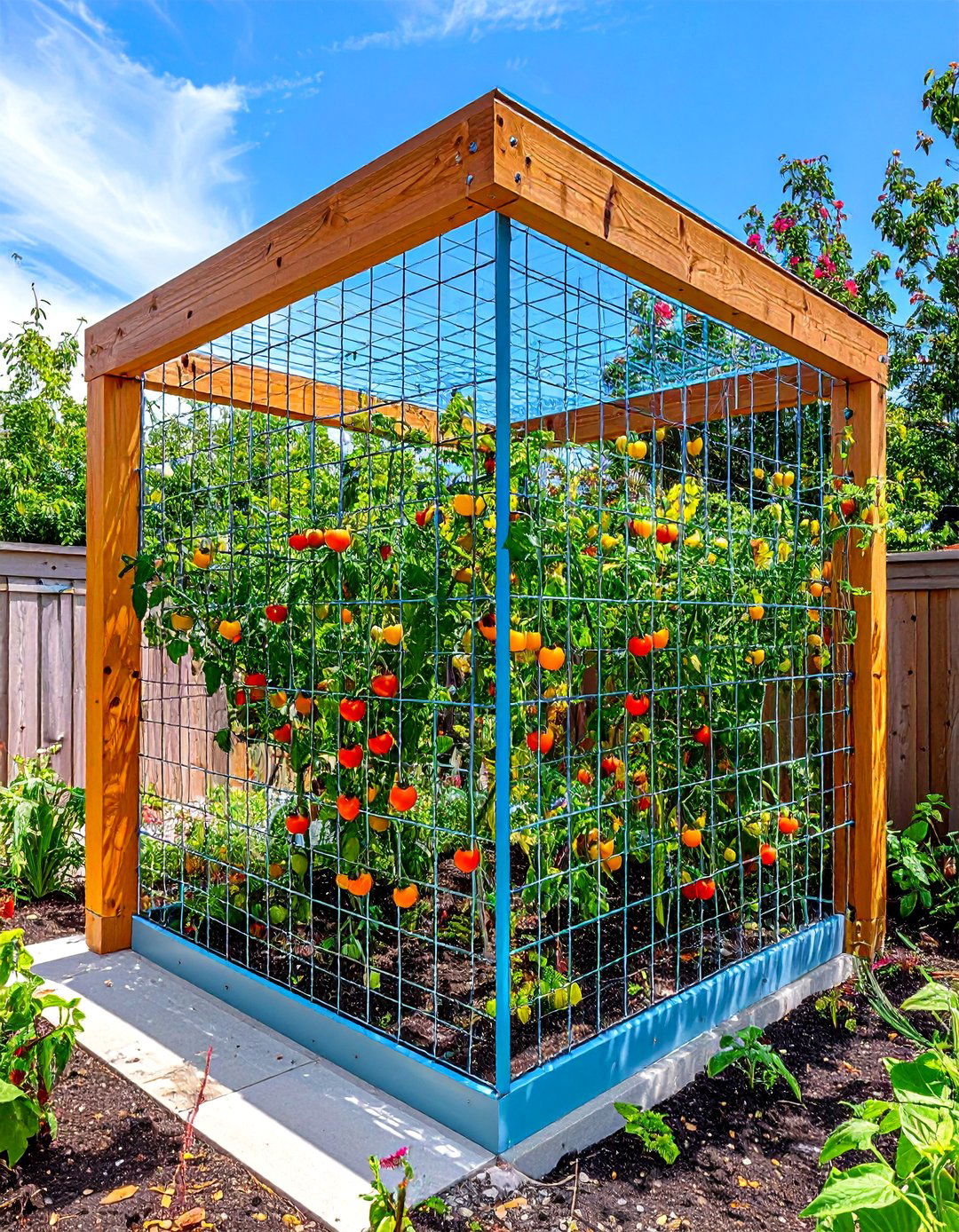
Mounting a wire grid or panel horizontally above plant rows allows vines to climb upward then spread as they ripen. Secure cattle panels or welded wire mesh atop posts 5–6' high, and train vines to climb into the overhead grid. This “ceiling” support keeps fruit suspended, maximizing airflow and preventing ground contact. Harvest by lifting fruit down from above—ideal for raised beds and small spaces.
14. Tripod Trellis
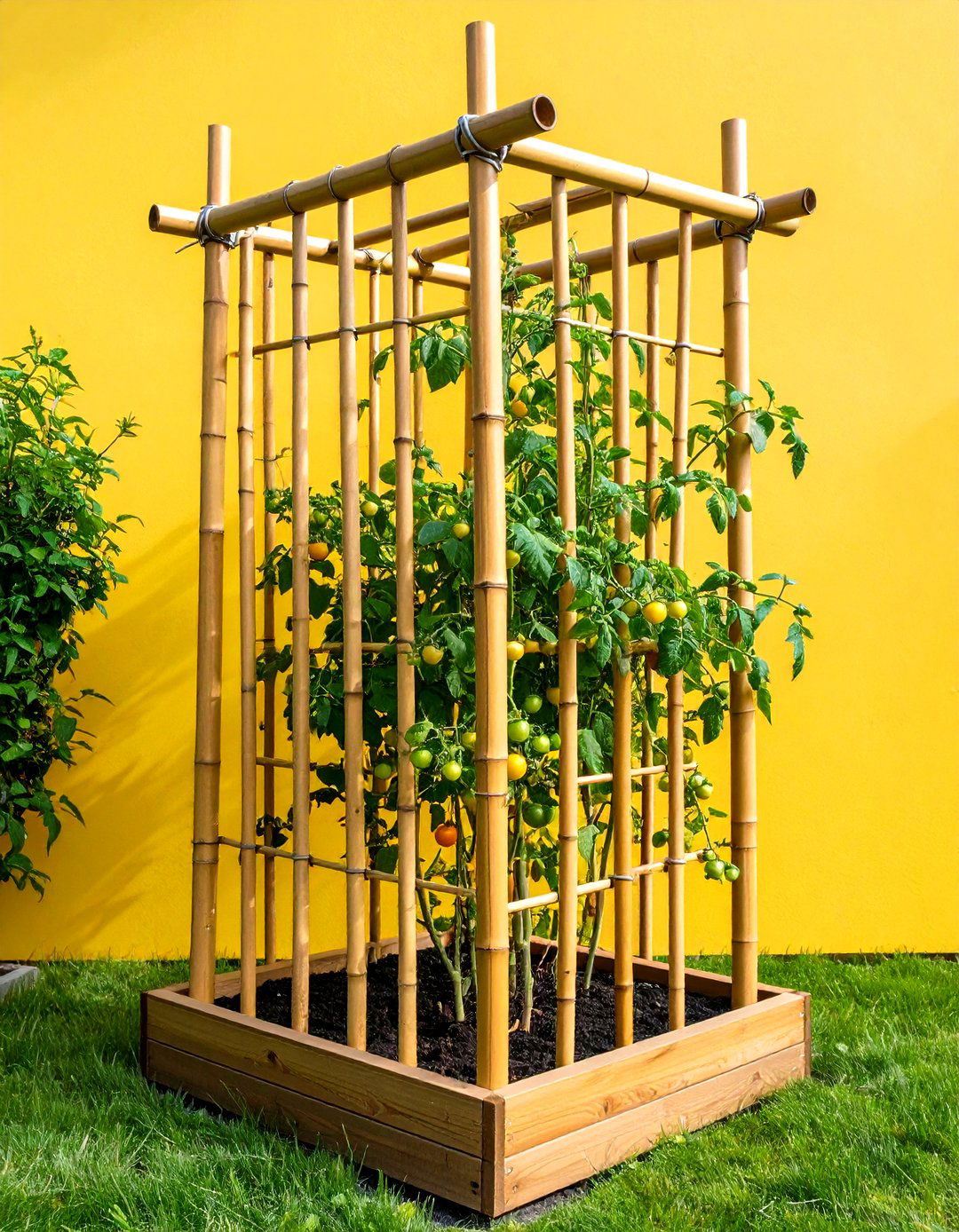
A simple tripod is made by tying three poles—wooden or bamboo—together at the top and spreading their legs into a stable base. Plant tomatoes in the center and guide vines up each leg. Tripods are portable, inexpensive, and require no horizontal supports. They work best for indeterminate varieties grown in containers or small beds. Tie vines loosely to each pole leg to prevent slippage as plants climb.
15. Pallet-Panel Trellis
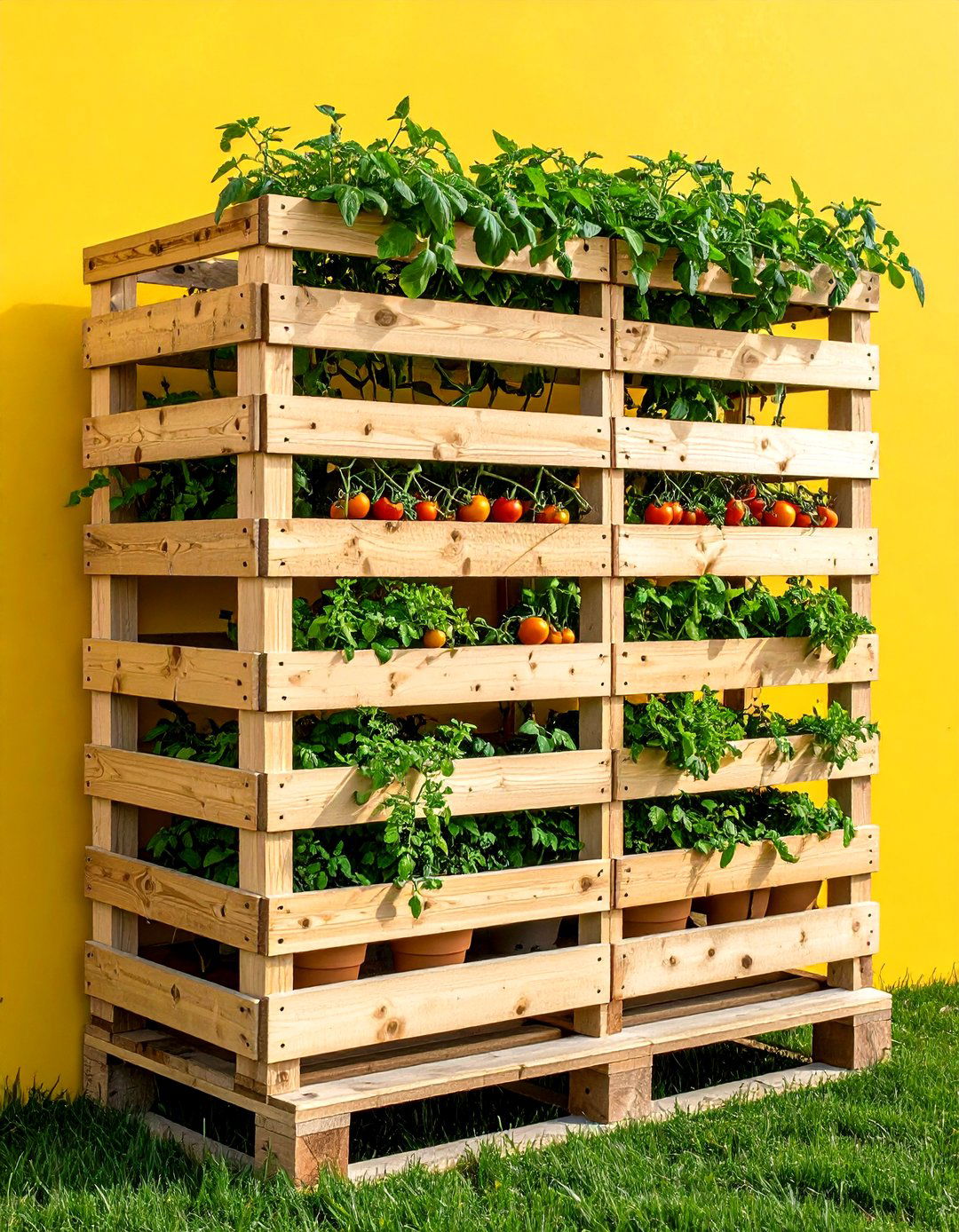
Upcycled wood pallets provide a ready-made frame of horizontal slats that vines can climb. Stand a pallet vertically, secure it between posts or to a wall, and plant tomatoes at its base. The slats act as natural footholds for vines to wrap around. Pallets offer a rustic look and are often free or low-cost. Treat or seal pallet wood to extend its lifespan in the garden.
16. Fence-Panel Trellis
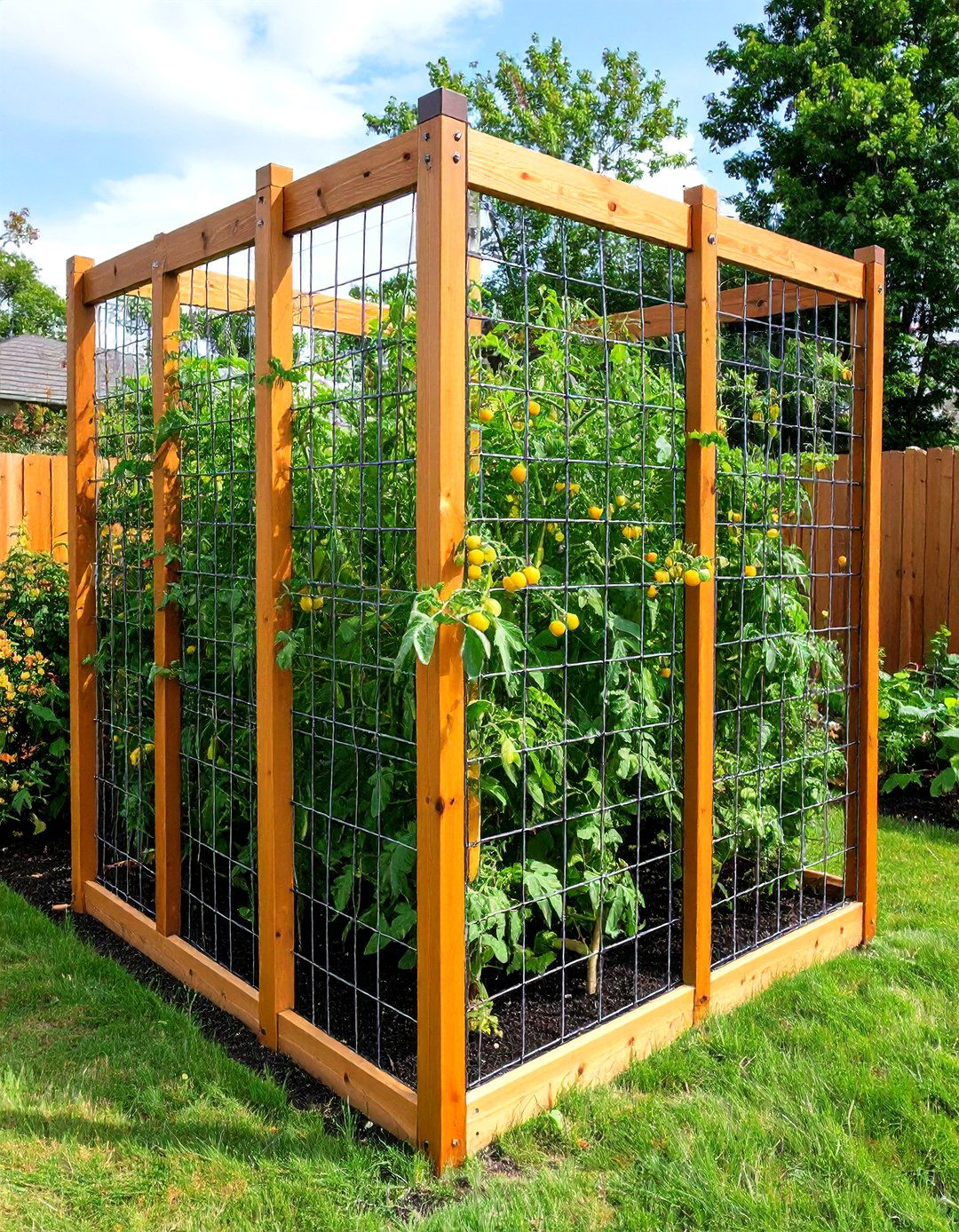
Livestock or hog panels—heavy-gauge wire mesh—can be fastened to T-posts or wooden posts to create long, sturdy trellises. Space panels parallel to planting beds, deep enough to resist heavy vines. Guide vines through the large openings and secure with plant clips. Fence panels support multiple plants along their length and can be reused for years. They’re ideal for large gardens and commercial plots needing robust, low-maintenance structures.
17. Planter-Box Trellis
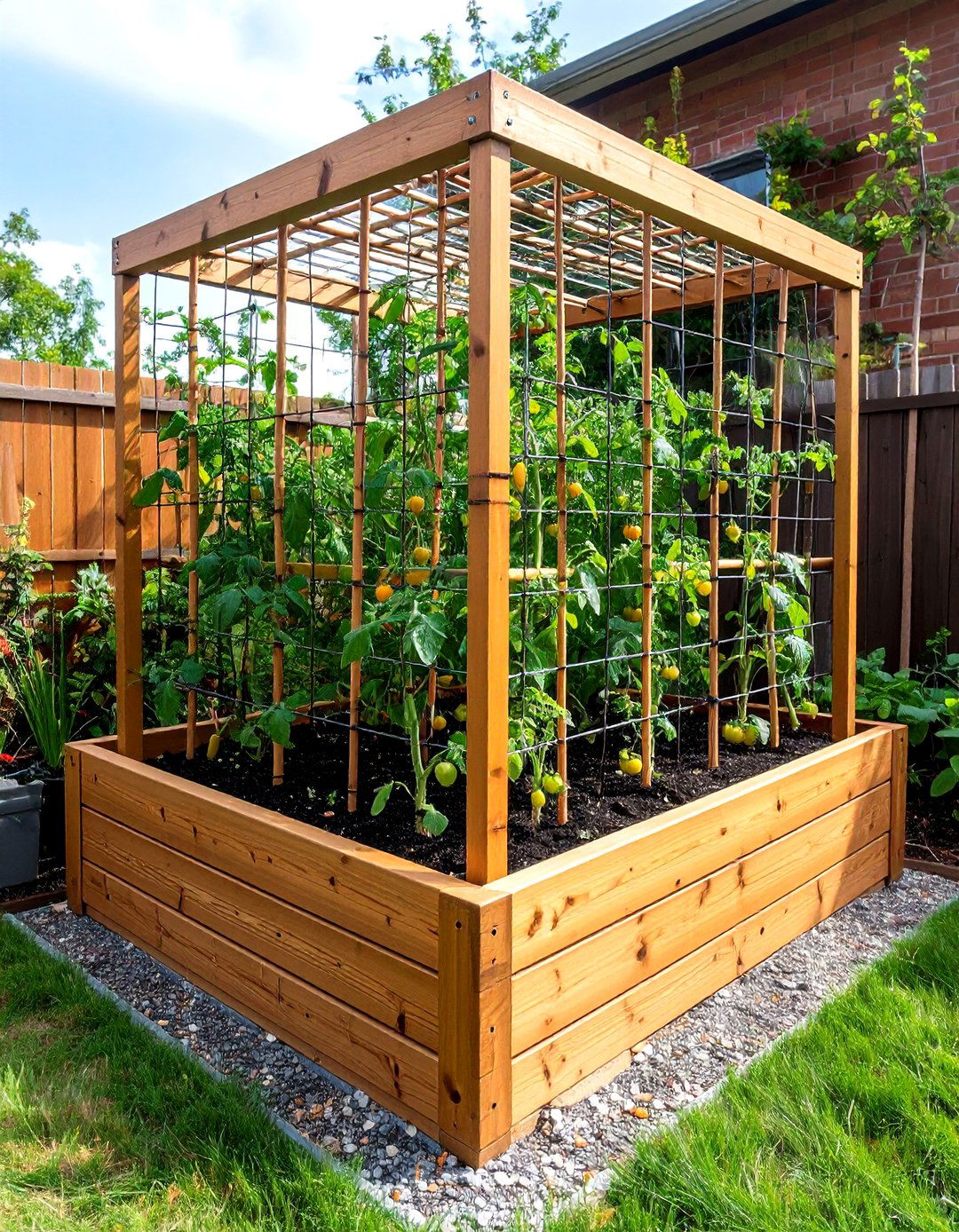
Combining raised planter boxes with vertical supports saves space and adds design flair. Build or buy a deep planter, plant tomatoes at one end, and affix a trellis—wire mesh, bamboo poles, or lattice—to the back. The contained soil warms quickly, boosting early growth, while the trellis provides immediate vertical support. This system suits patios, balconies, and small-footprint gardens.
18. Teepee (Tipi) Trellis
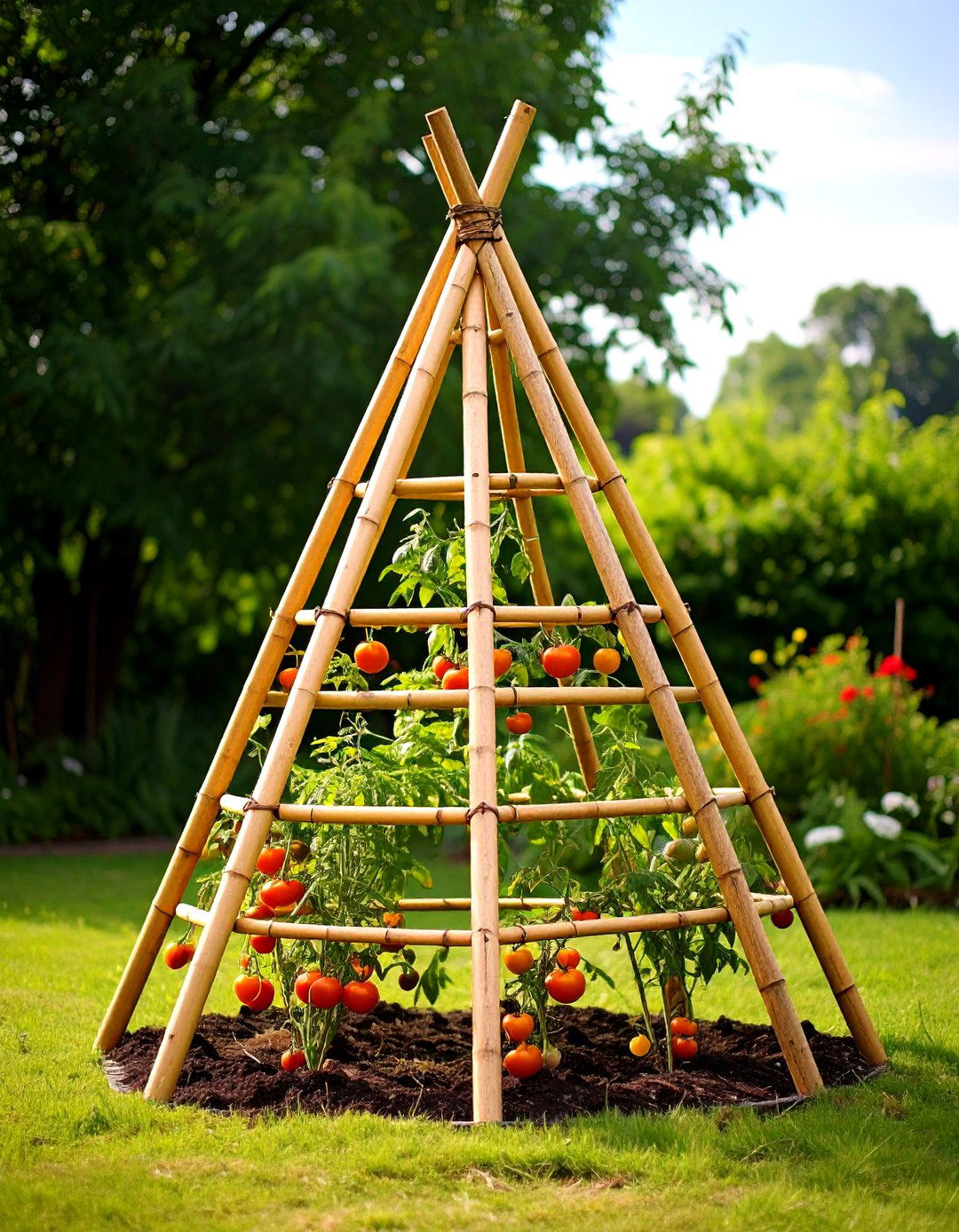
A bamboo teepee—similar to a cone but with sparser poles—creates an airy trellis that’s easy to build. Tie three or more long bamboo poles at the top and spread their bases into a circle. Plant tomatoes inside, and let vines climb the smooth poles, adding twine wraps as needed. The conical shape sheds rainwater and resists wind, making it stable for small to medium-sized plants.
19. Vertical Cable Trellis
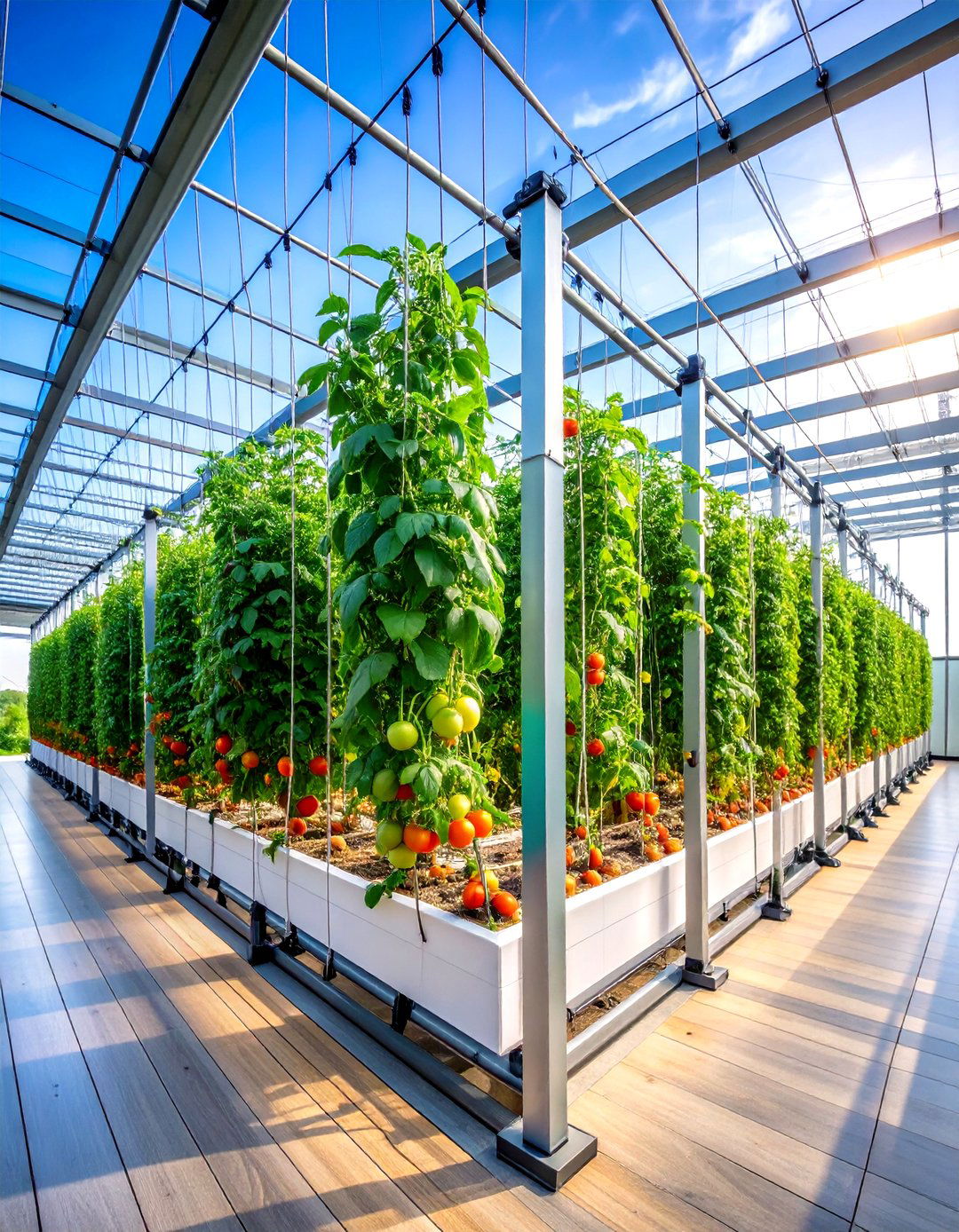
In greenhouse or high-tunnel settings, stainless-steel aircraft cable strung between rafters and posts serves as a high-strength overhead trellis. Attach roller-hook assemblies that dispense UV-resistant line and clips; as vines grow, lower the line to keep fruit accessible. This system supports very tall indeterminate varieties, maximizes vertical space, and allows precise vine management in controlled environments.
20. Overhead Tomato Tunnel
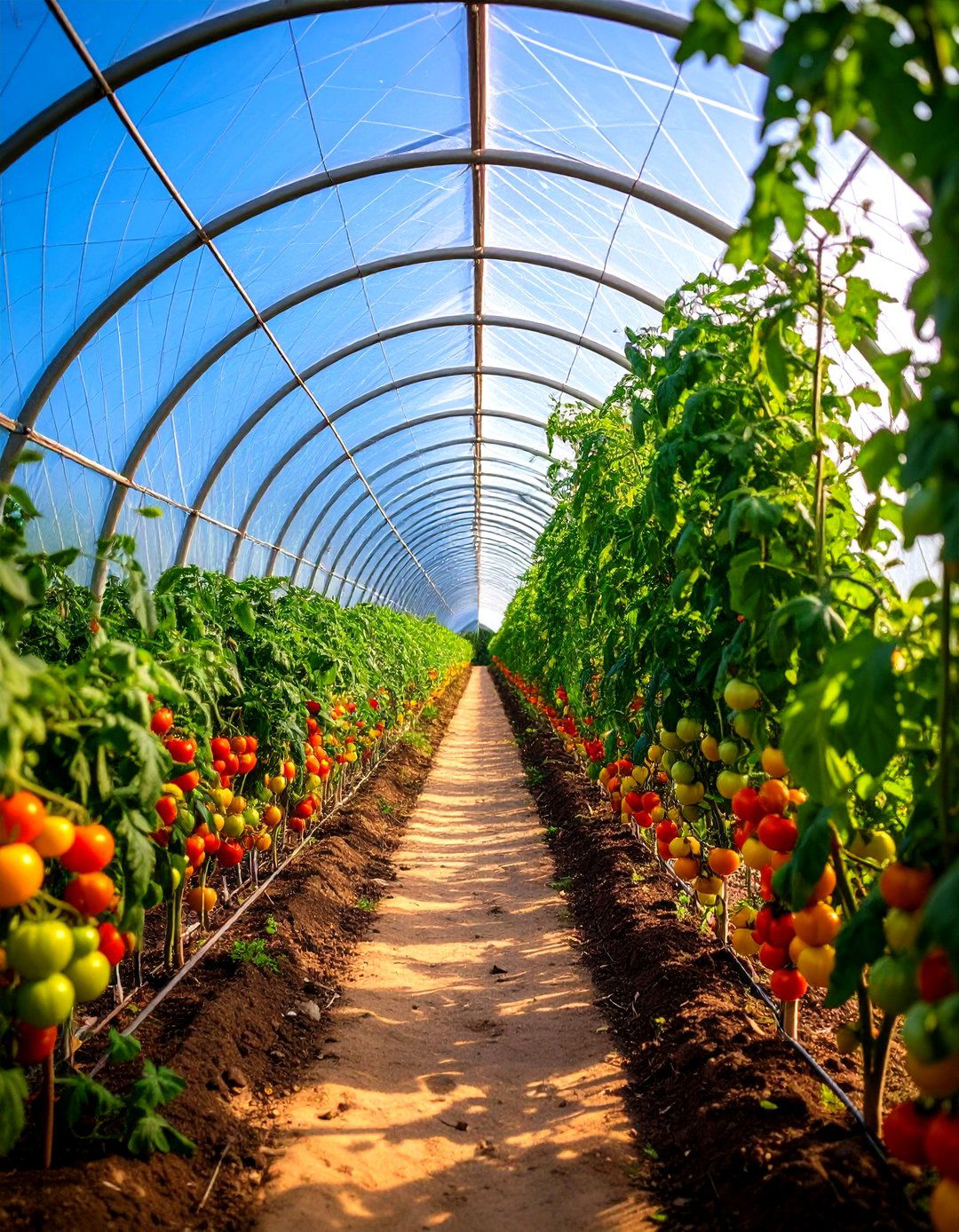
Building an overhead tunnel of cattle-panel arches or PVC hoops over a row creates a “vine tunnel” that supports climbing tomatoes on both sides. Install a series of hoops, drape wire mesh or cattle panel along them, and train vines upward. The tunnel protects plants from heavy rain while providing an immersive harvesting experience. It also doubles as a trellis for cucumbers and beans, enhancing garden versatility.
Conclusion:
Choosing the right tomato trellis hinges on your garden size, tomato variety, available materials, and aesthetic preferences. Simple stakes or cages suit small plots and beginners, while Florida weaves, wire grids, and cattle-panel structures offer robust support for extensive plantings. DIY options like bamboo frames, pallets, and PVC systems balance cost, reusability, and design flair. For serious growers, overhead cables and tunnel trellises maximize vertical real estate in protected environments. Whatever system you select, consistent training, timely tying, and appropriate pruning ensure vigorous growth, abundant yields, and healthier plants—making the effort of trellising well worth it.


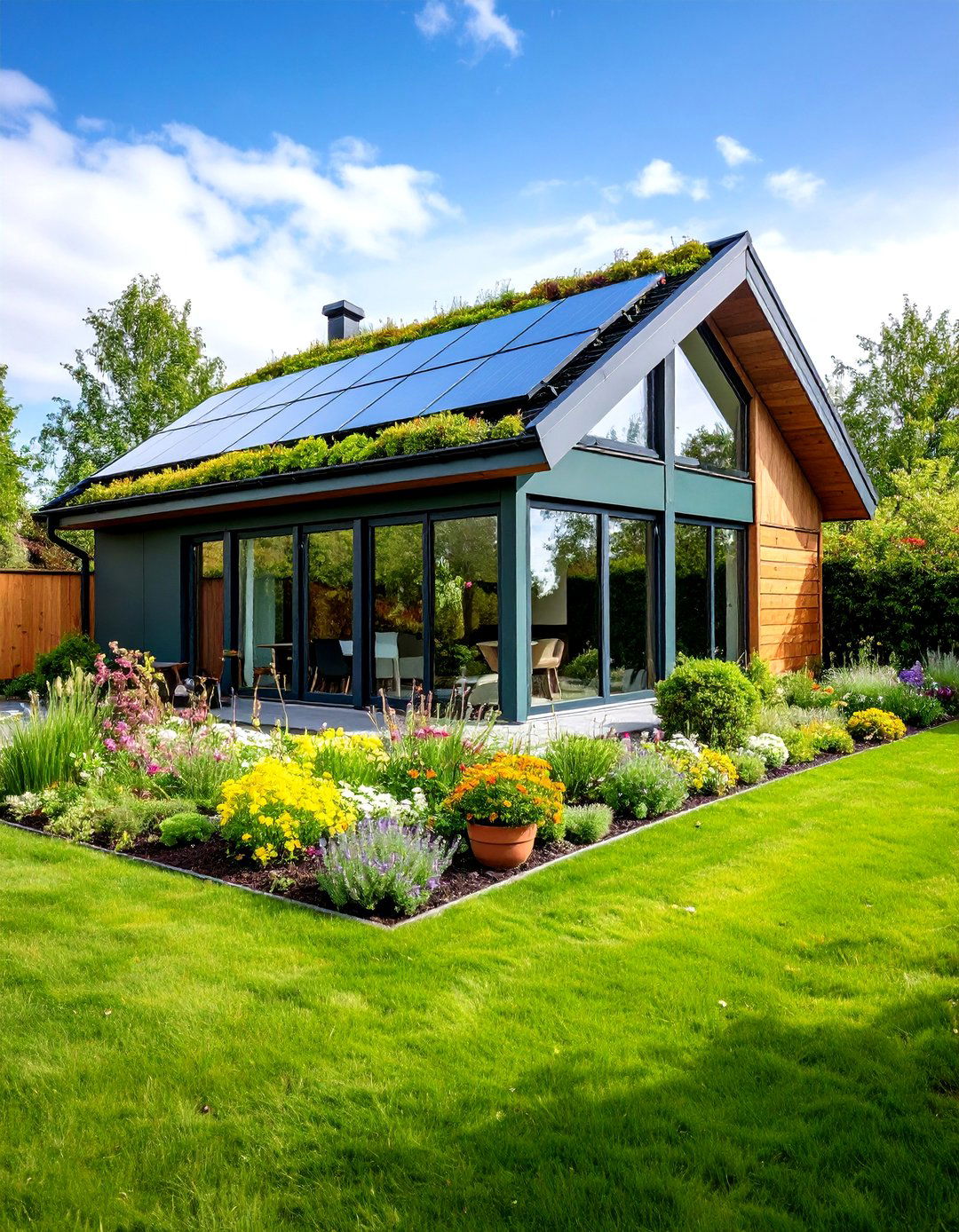
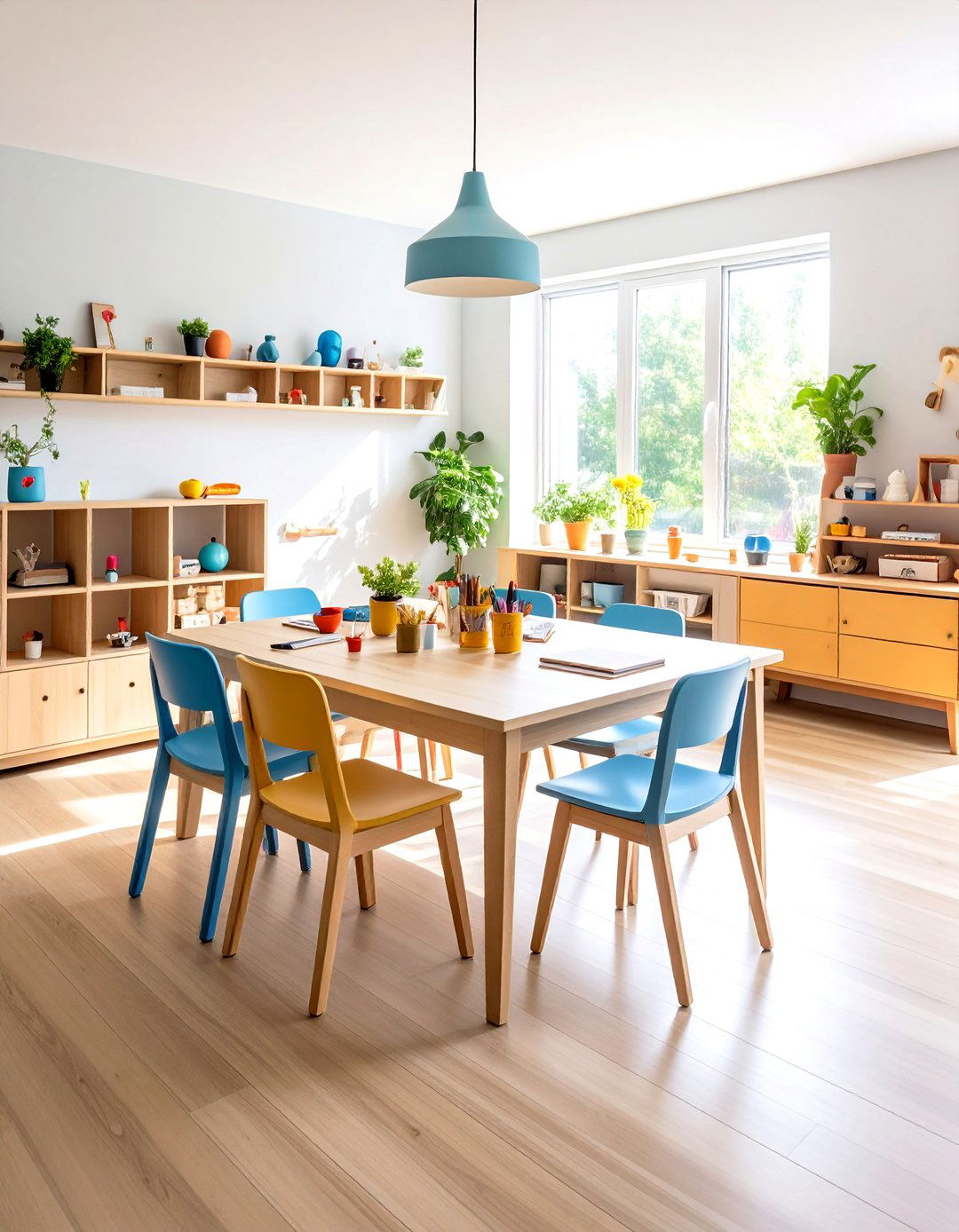

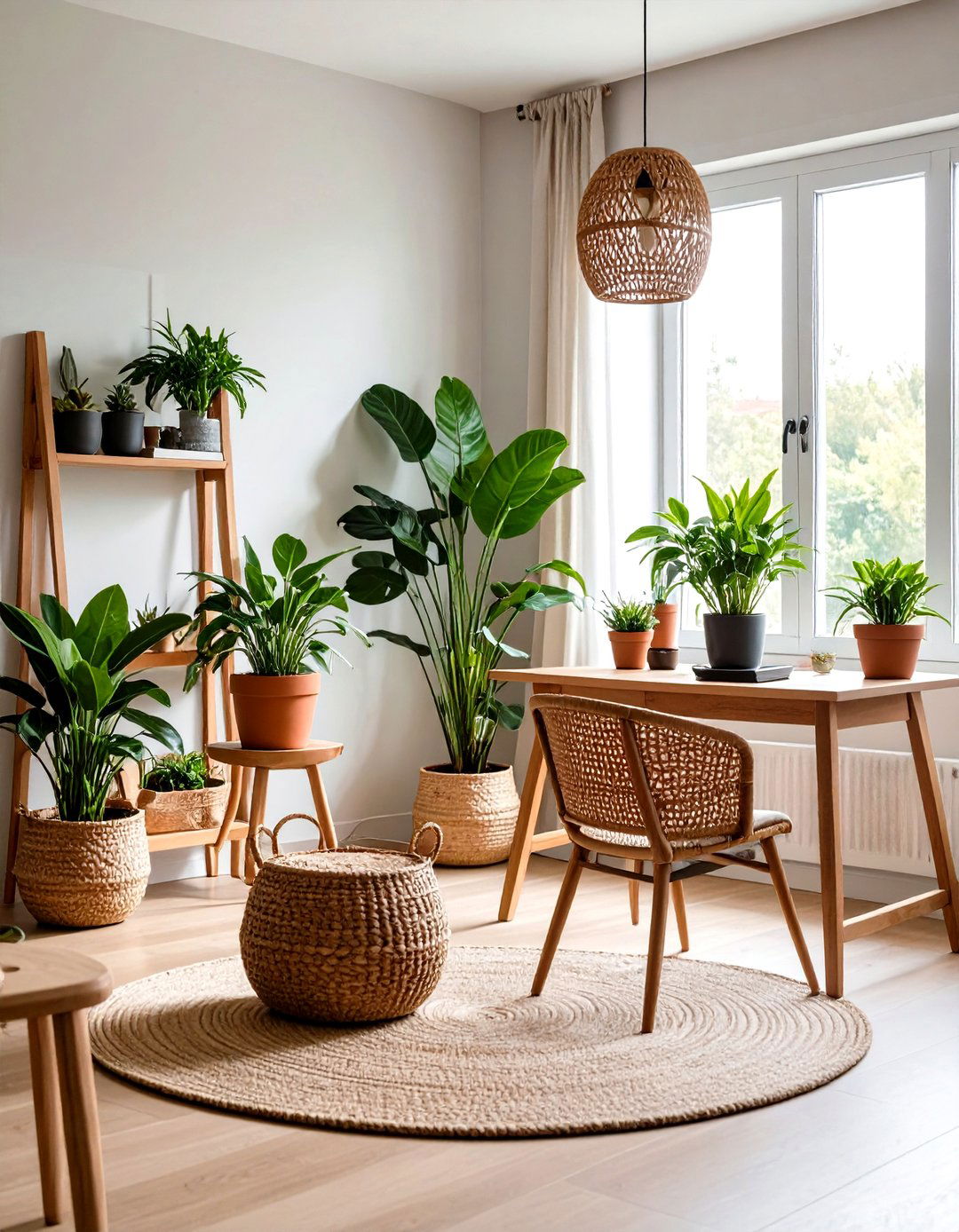
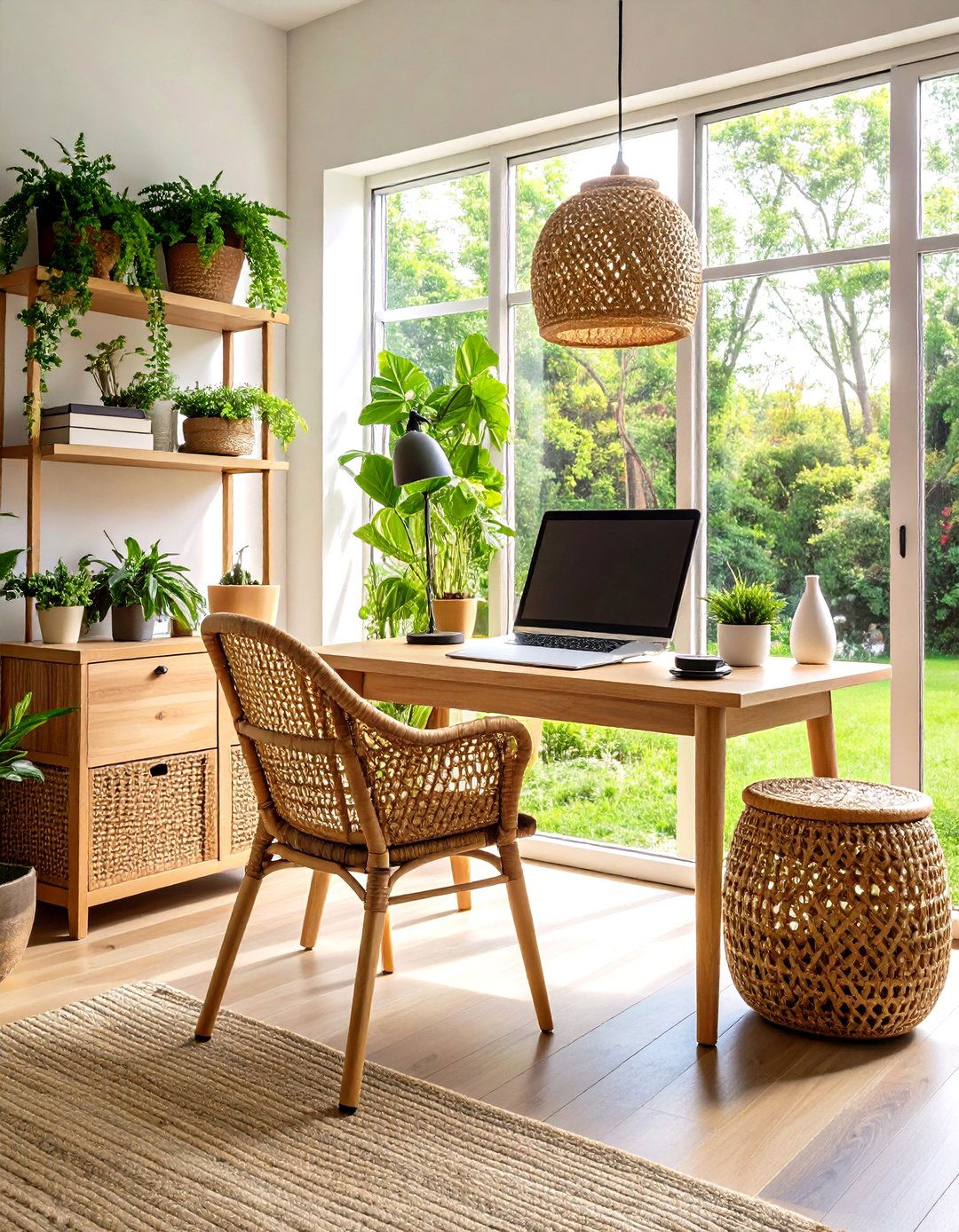

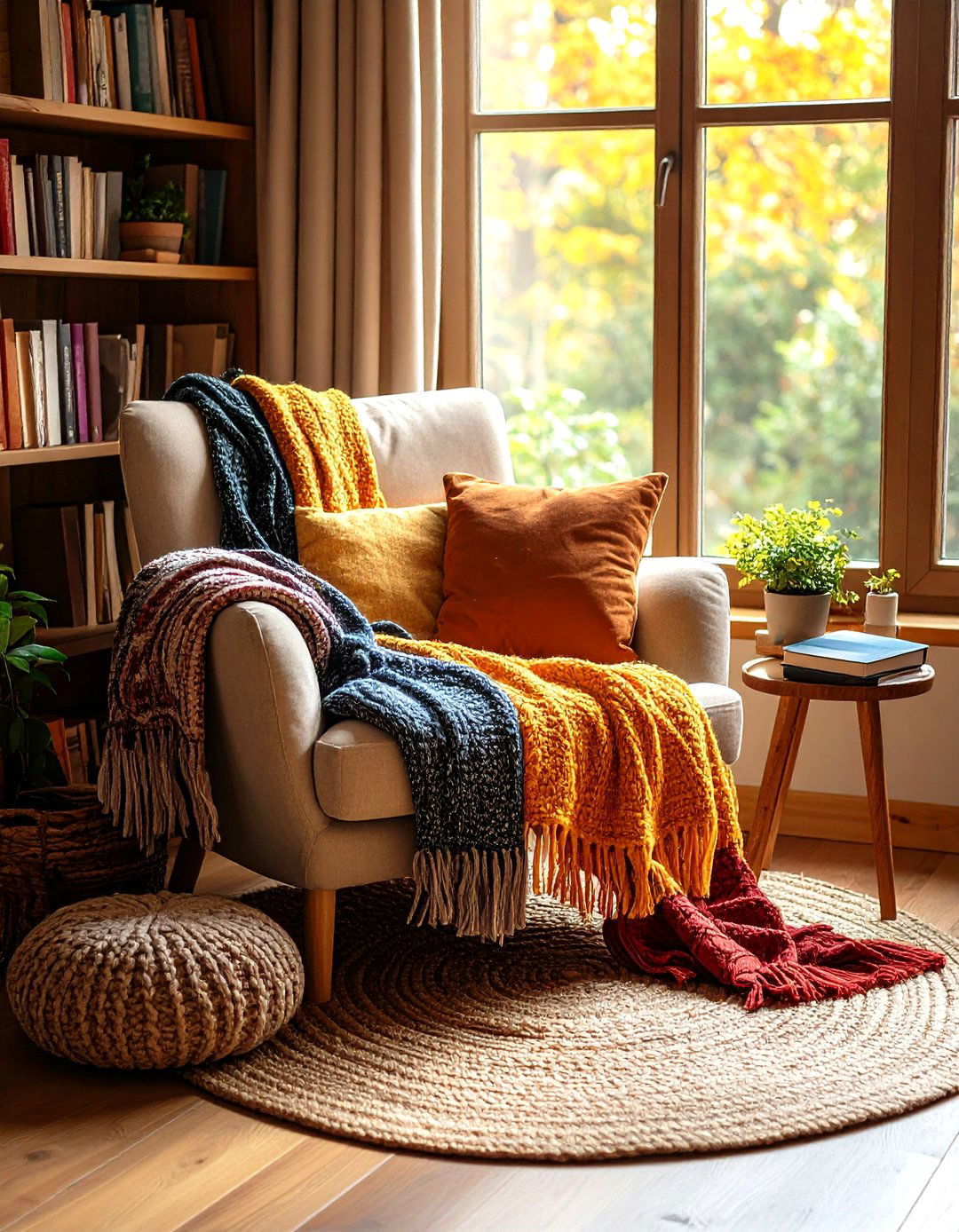

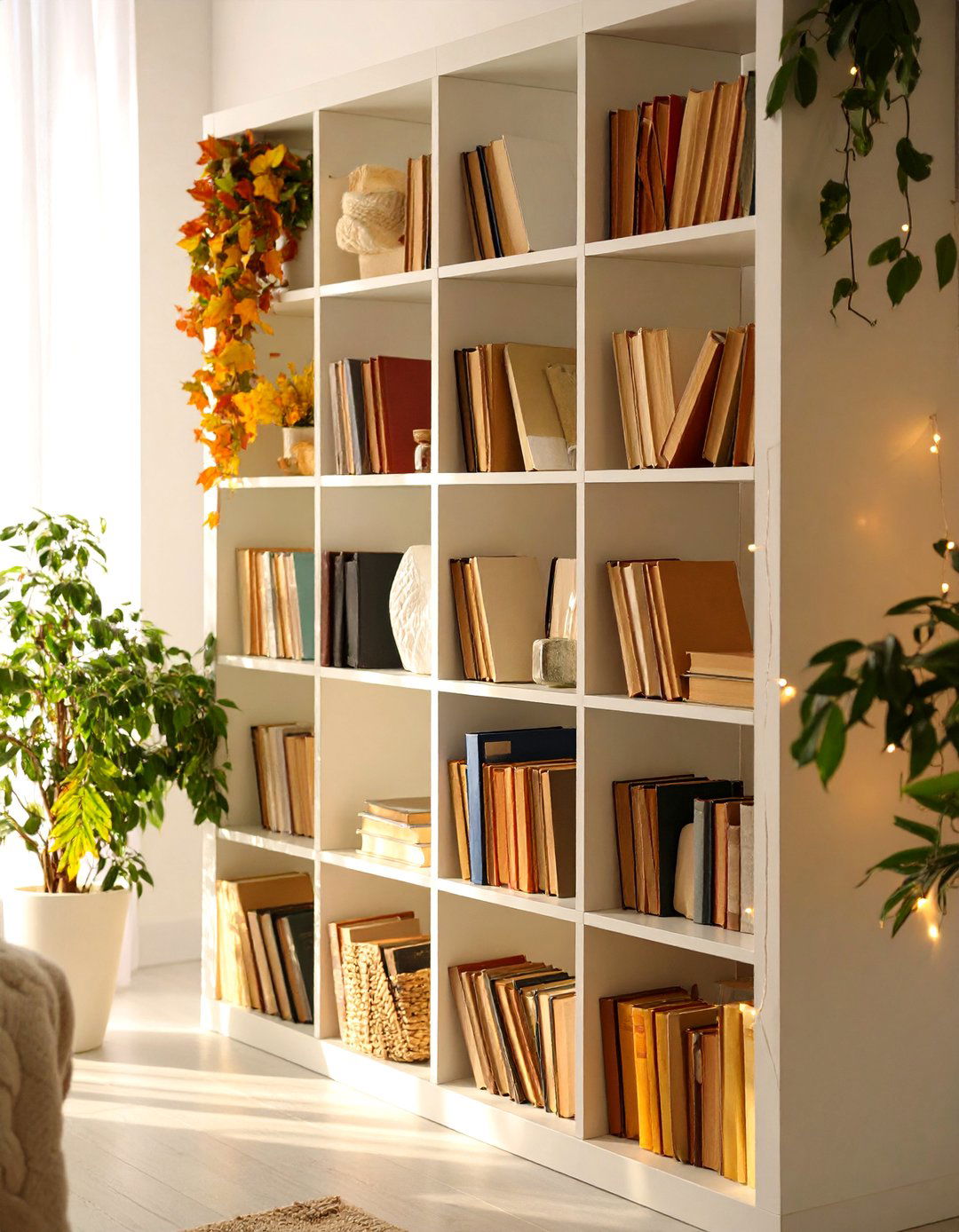

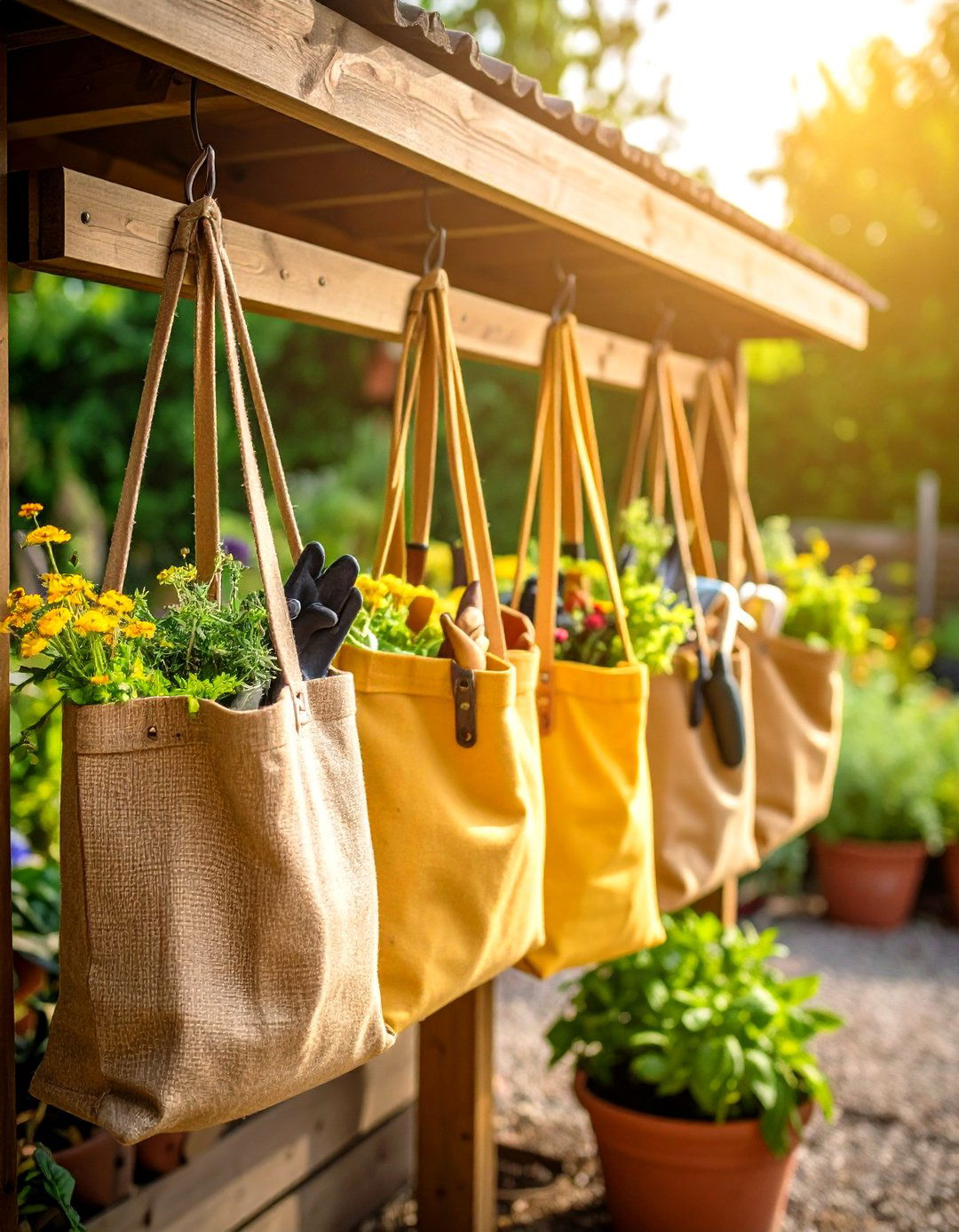
Leave a Reply